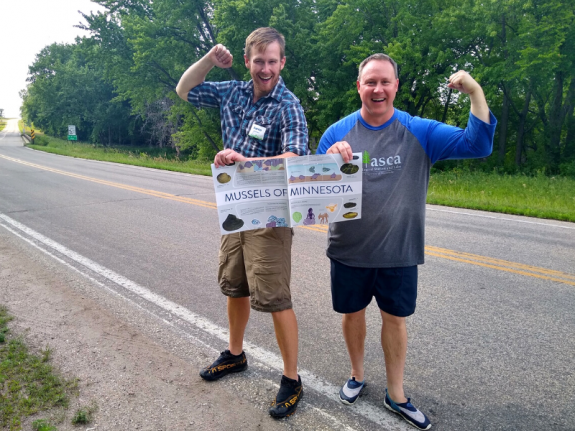
by Troy Goodnough
While billionaires are blasting off into outer space to find ways to appreciate Mother Earth and see it from a new perspective — organizations, like CURE are closer to the ground and down-to-earth. On Saturday, July 17, CURE, Land Stewardship Project, and Minnesota Master Naturalists hosted a Tallgrass Prairie BioBlitz at the Lac qui Parle State Park and WMA. A BioBlitz is a unique opportunity to survey a bunch of plant and animal life in one location, kind of like a biological check-up. It is wonderful to be with a congregation of people interested in learning about the beautiful creatures, large and small, that share our small part of planet Earth here in southwestern Minnesota. After connecting with old friends, being introduced to some cool new people, and checking out the silent auction — the main festivities of the day began. Several groups headed out into the prairie and fen to start their biological surveys. It was fun being around people who take the same pleasure in seeing butterflies, bugs, plants, and animals, as you do. Friends from the Minnesota Dragonfly Society were there, sharing their excitement about the amazingly winged creatures we enjoy each summer. For attendees not participating in a morning survey group, there were several presentations offered. I was excited to attend a presentation about Minnesota’s freshwater mussels. It was especially fantastic that the very knowledgeable and passionate presenter, Bernard Sietman, from the Minnesota Department of Natural Resources (MN DNR), was there.

Bernard gave an outstanding presentation about a fascinating topic I have only begun to learn about. We have about 50 freshwater mussels across Minnesota lakes and rivers. If you haven’t had an opportunity to learn more about them, you will want to! They are one of Earth’s amazing and under-told mysteries. Many of us may have seen a freshwater mussel, or clam, in a Minnesota lake near the shore. Still, we may not have known they existed in such diversity. This weekend we found over 12 species in the Lac qui Parle River. Even more unbelievable is the lifecycle of a freshwater mussel. The brief clamshell is this: clams have evolved and filled our rivers since the last glaciation.
Each clam has evolved to take advantage of a specific fish to help them propagate their young. Typically, at night, the clams open their shell and push out their gills which are filled with baby clams, called larvae. A clam’s gills also help them to breathe and eat. The clam also pushes a “lure” outside of the shell to capture the attention of their target fish. The clam’s “lure” could look like a crayfish, fish, minnow, or worm. But the point is the same, get a fish to come close to the clam’s gills and suck in larvae that will attach to fish gills and make their home there until they release. In a fascinating act of survival, each clam has evolved with a host fish species. The larvae live in fish gills without being detected and rejected by the fish as an intruder. Inside of a mature clam is a beautiful layer of mother of pearl or nacre. Generations ago, humans harvested clams by the ton for shirt buttons. Mussels are amazing animals that help clean up our rivers and lakes. Of course, when most people hear mussels, they think of the invasive and destructive zebra mussels. So, this was a great opportunity to learn more about our ecological helpers. Mussels are working overtime as they are continuously filtering the water.
After the presentation and grabbing some lunch, we headed out to the river to do our own mussel survey in the Lac qui Parle River. During our time in the river, and after feeling around in the water and searching with our eyes and with our feet, we were able to find many species. Some people in our survey group even found some mussel trails. This is where the mussel uses their foot to move around the mussel “bed.” The realization that there is this amazing world, hidden to most of us, of mussel communities living from decades to 100 years in our local riverbeds is awesome. The mussels have fantastic names, like Elktoe, Pocketbook, Pink Heelsplitter, Mapleleaf, and more! Understanding the lifecycle of the mussel also helps us understand why dams are so problematic for mussels. Without the right fish in our rivers or lakes, the mussels cannot propagate their young. Baby mussels cannot just live in any fish gills. Now, when I look at dams, I think about how it is also affecting the freshwater mussel population that might be available to help clean the water.
This weekend reminded me again that I don’t have to get a $250,000 ticket to outer space to see the real beauty of this planet. It is close to us. We might be missing it, living down in the water, driving over it every time we cross a bridge in our hometown. I hope we can all work to protect our freshwater mussels so they can do what they do best—clean up our waterways so we can enjoy them even more! I am very thankful for organizations like CURE, Land Stewardship Project, and Minnesota Master Naturalists. They bring people together to learn and share a meal—and to celebrate the magic right here on the tallgrass prairie.
—
Troy Goodnough is the Sustainability Director at the University of Minnesota, Morris.